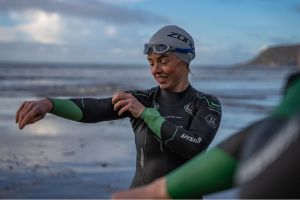As the allure of the triathlon season beckons, many swimmers find themselves making the leap from the controlled environment of the pool to the vast openness of lakes and seas. The journey can be both exhilarating and daunting, especially when gearing up for a sprint triathlon.
As you swap the familiar tiles of the pool for the energetic swim strokes of the open water, the transition demands a shift in mindset and technique. But fear not, with the right preparation, you can conquer the water and emerge triumphant on race day.
In this guide, we've got some top tips to smoothly transition from pool swimming to open water swimming to help you conquer the swim leg of your sprint triathlon with confidence.
Whether you're a seasoned pool swimmer or a newcomer to the world of triathlons, mastering the nuances of open water swimming is essential for success.
Tip 1: Utilize Buoyancy Shorts in Pool Training
To simulate the buoyancy effect of a wetsuit in open water, consider incorporating buoyancy shorts into your pool training sessions. Buoyancy shorts provide additional flotation, mimicking the feeling of buoyancy you'll experience when wearing a wetsuit during the race. By using buoyancy shorts, you can improve your body position, stroke efficiency, and overall comfort in the water. This training aid not only prepares you physically but also mentally for the buoyant sensation of swimming in open water, ensuring a smoother transition come race day.
Tip 2: Practice Deep Water Starts Ahead of Your Sprint Event
One crucial aspect of open water swimming is mastering the deep water starts and treading water. Unlike the pool, where you push off from the wall, open water races sometimes begin with participants treading water in deeper waters.
Treading water is also beneficial if you need a breather during the triathlon swim and can be effective way to reset and get back into a good swim technique.
Start by treading water in the deep end, then simulate a race start by swimming hard from a stationary position. This helps improve your ability to handle the initial buzz of a triathlon swim and boosts your confidence in deep water.
Regular practice of deep water starts can enhance your ability to navigate through the initial jostling and find your rhythm early in the race.
Tip 3: Sighting in the Pool & Sighting in Open Water
Sighting is a crucial skill in open water swimming, allowing you to navigate efficiently without veering off course. Sighting refers to the technique of lifting your head to look for landmarks or buoys to navigate. Practicing this skill in the pool is crucial before heading into open water.
Begin by practicing sighting in the pool, incorporating it into your regular swimming sessions. Focus on lifting your head to glance forward at a target periodically without disrupting your stroke rhythm. By mastering sighting in the pool, you'll develop the muscle memory and confidence needed to sight effectively during the race.
Once you've honed your sighting skills in the pool, it's time to put them to the test in open water. Find a lake or sea where you can practice swimming in unfamiliar surroundings. Start by swimming along a straight line and sighting regularly to maintain your course. Gradually increase the difficulty by incorporating turns and navigating around, preparing you for the challenges of your upcoming triathlon.
How To Swim a Sprint Triathlon
Transitioning from pool swimming to open water swimming is a pivotal step in preparing for a sprint triathlon. By following ZONE3’s top tips and incorporating them into your training regimen, you'll build the necessary skills and confidence to thrive in the open water environment.
Embrace the challenges, stay consistent in your practice, and visualise success as you embark on this exhilarating journey towards your sprint triathlon goals.
























